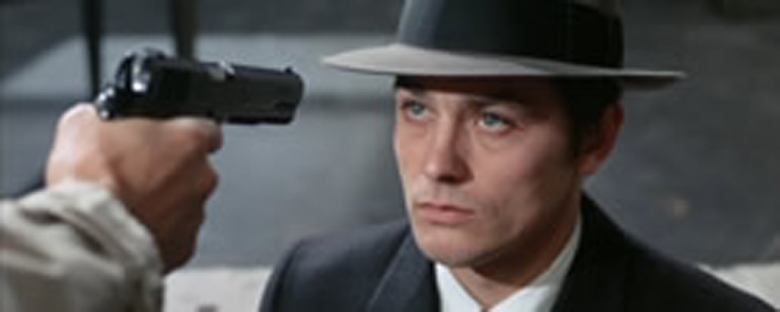Reviews
Jean-Pierre Melville
France, 1967
Credits
Review by Rumsey Taylor
Posted on 25 July 2004
Source New Yorker Films VHS
Related articles
Reviews: Le Doulos
Reviews: Army of Shadows
Reviews: Le Cercle Rouge
Alain Delon’s Jef Costello has an esteemed reputation for his efficiency as a killer-for-hire. His presence in Le Samouraï exudes capability; he is always straight-faced, predominantly unaffected by anything that happens to him, focused, able, and always silent. Unfortunately, he is also discrete. Costello is usually dressed in a trench coat buttoned to the collar and fedora positioned unergonomically, with its brim perfectly parallel to the floor. Le Samouraï honors noir’s fundamental trait in that its style compromises plausibility — its principal character, in dress, is even burdened by this obligatory toll. In his first job detailed in the film, he shoots the owner of a nightclub and is promptly identified by his attire and placed in a police lineup.
Noir traditionally employs icons, specifically in its characterizations. Le Samouraï is inventive in how it seems to identify such icons, as with Costello’s trademark outfit. At the ensuing lineup, he is placed among a handful of suspects in a room and is told to exchange his coat and hat with two other suspects. His traits are so distinct that witnesses enter and identify the particular hat, coat, and face as components of the singularly guilty party. It is a sublimely farcical scene that seems to acknowledge that the film’s inclusion of iconic noir elements is necessary; Costello is burdened because he looks like a contract killer.
His traits entirely one-sided and his wardrobe limited, Costello is more of a cartoon than he is a realistic character. He, as with many of the players in this film, is explicitly identifiable, and his actions and motivations are always clear. In short, Le Samouraï’s narrative players are designed for easy interpretation. This fosters the plot’s complication, as well as Jean-Pierre Melville’s inimitably stylistic filmmaking: foremost, his reliance upon staging and action and not dialogue. Melville is playing the game according to his own rules and with the same tools at his disposal as the genre’s pioneers.
Costello is spared, however, by the witness who got the best glimpse of him: a cocktail lounge singer. At the lineup, she denies that he is responsible for the death, yet her eye contact transmits a connection. Costello looks back at her, realizing she has somehow implicated him in a larger crime. This action triggers two more thematic trademarks of noir: one, that a principal character is at his most activated during self-preservation, and second, that a woman is man’s most dangerous enemy.
Costello is pitted against this woman, and it is to his disadvantage as he is incapable of combating her. He discovers the clarity of her connection to his crime and approaches her, his final target, with a gun with an empty chamber.
We don’t do comments anymore, but you may contact us here or find us on Twitter or Facebook.



